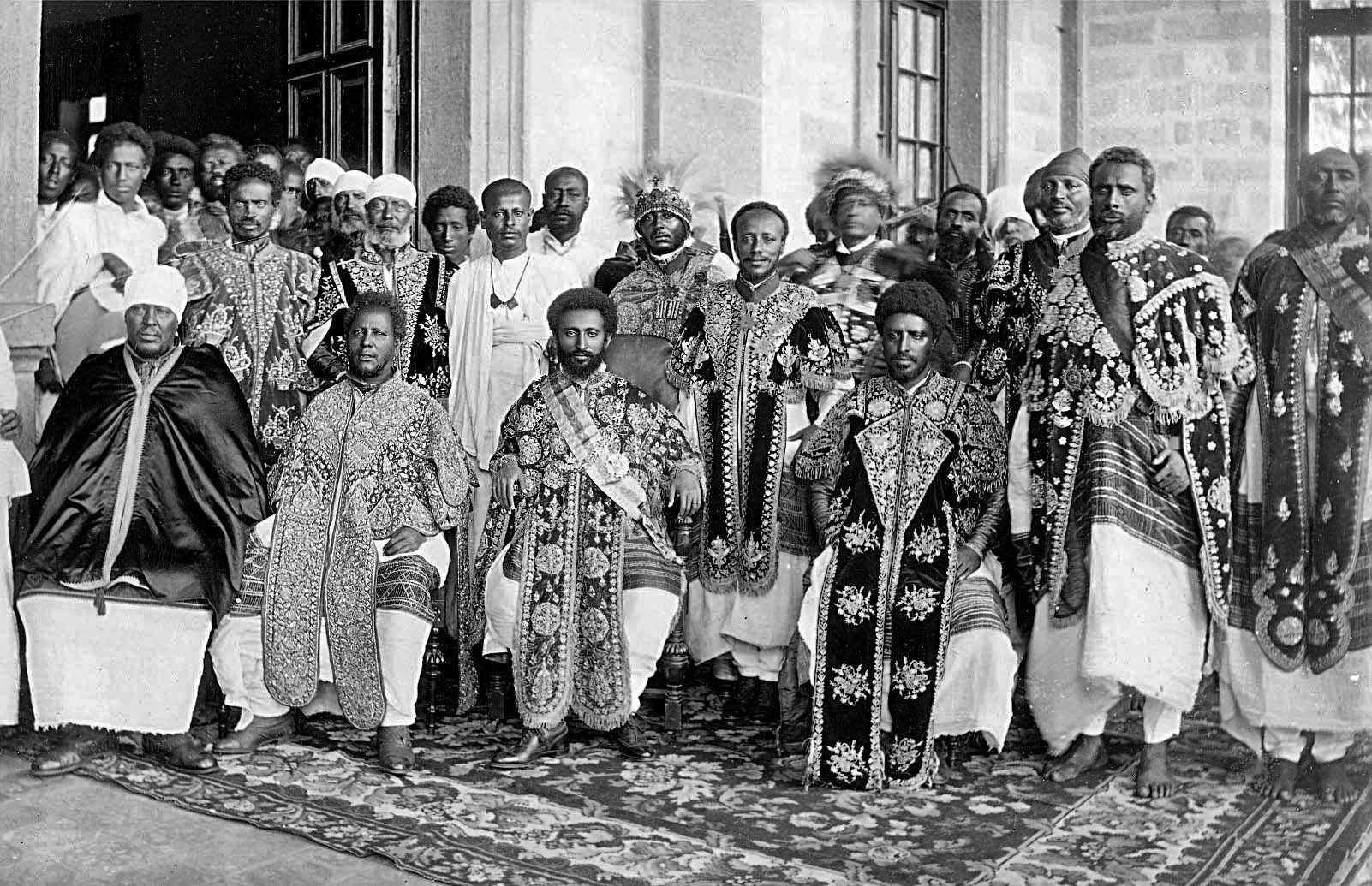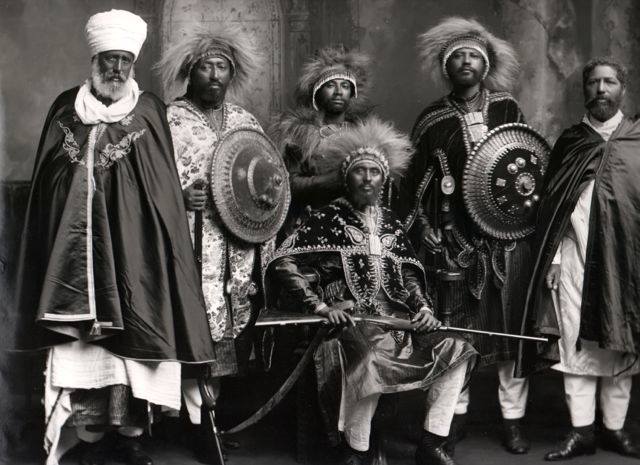|
Iyasu I
Iyasu I ( Ge'ez: ኢያሱ ፩; 1654 – 13 October 1706), throne name Adyam Sagad (Ge'ez: አድያም ሰገድ), also known as Iyasu the Great, was Emperor of Ethiopia from 19 July 1682 until his death in 1706, and a member of the Solomonic dynasty. Described as the last “great” Gondarine monarch, Iyasu temporarily halted the trend of decline through his brilliance as a military leader, reestablishing control over rebellious vassals and conquering areas to the south of his domain. In addition to his military and political exploits, Iyasu was a patron of architecture, arts and literature. He also attempted to settle doctrinal differences within Ethiopia's Coptic Church, but without long-lasting success. Iyasu was deposed by his own son Tekle Haymanot I in 1706 and assassinated by the relatives of one of his concubines. A series of ineffectual emperors followed and imperial power declined until the advent of Tewodros II in the middle of the nineteenth century. Early life A ... [...More Info...] [...Related Items...] OR: [Wikipedia] [Google] [Baidu] |
Emperor Of Ethiopia
The emperor of Ethiopia (, "King of Kings"), also known as the Atse (, "emperor"), was the hereditary monarchy, hereditary ruler of the Ethiopian Empire, from at least the 13th century until the abolition of the monarchy in 1975. The emperor was the head of state and head of government, with ultimate executive power, executive, judicial power, judicial and legislative power in that country. A ''National Geographic'' article from 1965 called Imperial Ethiopia "nominally a constitutional monarchy; in fact it was a benevolent dictatorship, benevolent autocracy". Title and style The title "King of Kings", often rendered imprecisely in English as "emperor", dates back to ancient Mesopotamia, but was used in Aksumite Empire, Axum by King Sembrouthes (). However, Yuri Kobishchanov dates this usage to the period following the Persian Empire, Persian victory over the Roman Empire, Romans in 296–297. The most notable pre-Solomonic usage of the title "Negusa Nagast" was by Ezana of Ax ... [...More Info...] [...Related Items...] OR: [Wikipedia] [Google] [Baidu] |
Fesseha Krestos
Fesseha Krestos (lit: The joy of Christ) was an Ethiopian commander of the royal guard regiment under Iyasu I, he was one of the closest confidants of the Emperor. Biography Fesseha is mentioned for the first time in the chronicle of Emperor Yohannes I with the title of Fitawrari in October 1677. On 15th of July 1682, the ailing Emperor Yohannes I made Iyasu his successor. Fesseha Krestos was among the dignitaries witnessing Yohannes I final proclamation, other notables were Kanafero and Za-Wald (both Azzaz), basha Lesana Krestos, blattengeta Akala Krestos, and the dejazmach's Anestasyos and Delba Iyasus. Emperor Yohannes died on 19 July 1682, and the new monarch Iyasu I, appointed Fesseha Krestos as the regent of Gojjam. He had a brief tenure, as he was summoned to return to Gondar where he was made commander of one the royal guard regiments. In 1689, angered by the massacre of Christians by the northerly Shankellas in the Shire desert, Iyasu I despatched Fesseha, wh ... [...More Info...] [...Related Items...] OR: [Wikipedia] [Google] [Baidu] |
Fitawrari
Until the end of the Ethiopian monarchy in 1974, there were two categories of nobility in Ethiopia and Eritrea. The Mesafint ( , modern transcription , singular መስፍን , modern , "prince"), the hereditary royal nobility, formed the upper echelon of the ruling class. The Mekwanint ( , modern , singular መኰንን , modern or , "officer") were the appointed nobles, often of humble birth, who formed the bulk of the aristocracy. Until the 20th century, the most powerful people at court were generally members of the ''Mekwanint'' appointed by the monarch, while regionally, the ''Mesafint'' enjoyed greater influence and power. Emperor Haile Selassie greatly curtailed the power of the ''Mesafint'' to the benefit of the ''Mekwanint'', who by then were essentially coterminous with the Ethiopian government. The ''Mekwanint'' were officials who had been granted specific offices in the Abyssinian government or court. Higher ranks from the title of ''Ras'' descending through to ''B ... [...More Info...] [...Related Items...] OR: [Wikipedia] [Google] [Baidu] |
Anestasyos
Anestasyos (died 2 August 1688), was one of the most prominent figures of 17th-century Ethiopia. He held several positions during the reigns of Fasilides, Yohannes I and Iyasu I. The latter relied on Anestasyos military prowess and made him Ras Bitwoded. Over the course of his career he became the provincial governor of Amhara, Damot, Semien and Shewa. Biography Anestasyos was the son of Ras Yolyos by princess Malakotawit, daughter of the Solomonic Amhara Emperor Susenyos. His father, Yolyos was recognized and remembered as an Orthodox Christian martyr, following Susenyos abdication and the restoration of Ethiopian Orthodox Tewahedo Church in 1632. Anestasyos therefore seemed to have been favored by his uncle, Emperor Fasilides, who was a devout Orthodox Christian. Anestasyos attained the title of Dejazmach during his reign. During Yohannes I reign, Dejazmach Anestasyos was the governor of Semien Province with the honorific title of Aggafari. On 15 July 1682, the ailin ... [...More Info...] [...Related Items...] OR: [Wikipedia] [Google] [Baidu] |
Dejazmach
Until the end of the Ethiopian monarchy in 1974, there were two categories of nobility in Ethiopia and Eritrea. The Mesafint ( , modern transcription , singular መስፍን , modern , "prince"), the hereditary royal nobility, formed the upper echelon of the ruling class. The Mekwanint ( , modern , singular መኰንን , modern or , "officer") were the appointed nobles, often of humble birth, who formed the bulk of the aristocracy. Until the 20th century, the most powerful people at court were generally members of the ''Mekwanint'' appointed by the monarch, while regionally, the ''Mesafint'' enjoyed greater influence and power. Emperor Haile Selassie greatly curtailed the power of the ''Mesafint'' to the benefit of the ''Mekwanint'', who by then were essentially coterminous with the Ethiopian government. The ''Mekwanint'' were officials who had been granted specific offices in the Abyssinian government or court. Higher ranks from the title of ''Ras'' descending through to ''B ... [...More Info...] [...Related Items...] OR: [Wikipedia] [Google] [Baidu] |
Akala Krestos
Akala Krestos (died 3 September 1685) was a high court administrator during the reigns of Yohannes I and Iyasu I. He started his career during the reign of Emperor Fasilides. However it's in the year 1677 that he was mentioned as an official at the court of Yohannes I, with the title of Bagerond. By 1682 he was serving as Blattengeta. On 15 July 1682, the ailing Emperor Yohannes I made Iyasu I his successor. Blattengeta Akala Krestos was among the dignitaries witnessing Yohannes I final proclamation, other notables were Kanafero and Za-Wald (both Azzaz), basha Lesana Krestos, dejazmach's Anestasyos and Delba Iyasus, and fitawrari Fesseha Krestos. On 20 March 1683 he was relieved from his duties. He died almost certainly in Gondar Gondar, also spelled Gonder (Amharic: ጎንደር, ''Gonder'' or ''Gondär''; formerly , ''Gʷandar'' or ''Gʷender''), is a city and woreda in Ethiopia. Located in the North Gondar Zone of the Amhara Region, Gondar is north of Lake Tana ... [...More Info...] [...Related Items...] OR: [Wikipedia] [Google] [Baidu] |
Lesana Krestos
Pietro Lesana is an Italian bobsledder who competed in the mid-1960s. He won a silver medal in the four-man event at the 1965 FIBT World Championships in St. Moritz St. Moritz ( , , ; ; ; ; ) is a high Alpine resort town in the Engadine in Switzerland, at an elevation of about above sea level. It is Upper Engadine's major town and a municipality in the administrative region of Maloja in the Swiss .... ReferencesBobsleigh four-man world championship medalists since 1930 Italian male bobsledders Living people Year of birth missing (living people) Place of birth missing (living people) 20th-century Italian sportsmen {{Italy-bobsleigh-bio-stub ... [...More Info...] [...Related Items...] OR: [Wikipedia] [Google] [Baidu] |
Ethiopian Aristocratic And Court Titles
Until the end of the Ethiopian Empire, Ethiopian monarchy in 1974, there were two categories of nobility in Ethiopia and Eritrea. The Mesafint ( , modern transcription , singular መስፍን , modern , "prince"), the hereditary royal nobility, formed the upper echelon of the ruling class. The Mekwanint ( , modern , singular መኰንን , modern or , "officer") were the appointed nobles, often of humble birth, who formed the bulk of the aristocracy. Until the 20th century, the most powerful people at court were generally members of the ''Mekwanint'' appointed by the monarch, while regionally, the ''Mesafint'' enjoyed greater influence and power. Emperor Haile Selassie greatly curtailed the power of the ''Mesafint'' to the benefit of the ''Mekwanint'', who by then were essentially coterminous with the Ethiopian government. The ''Mekwanint'' were officials who had been granted specific offices in the Abyssinian government or court. Higher ranks from the title of ''Ras'' descendi ... [...More Info...] [...Related Items...] OR: [Wikipedia] [Google] [Baidu] |



